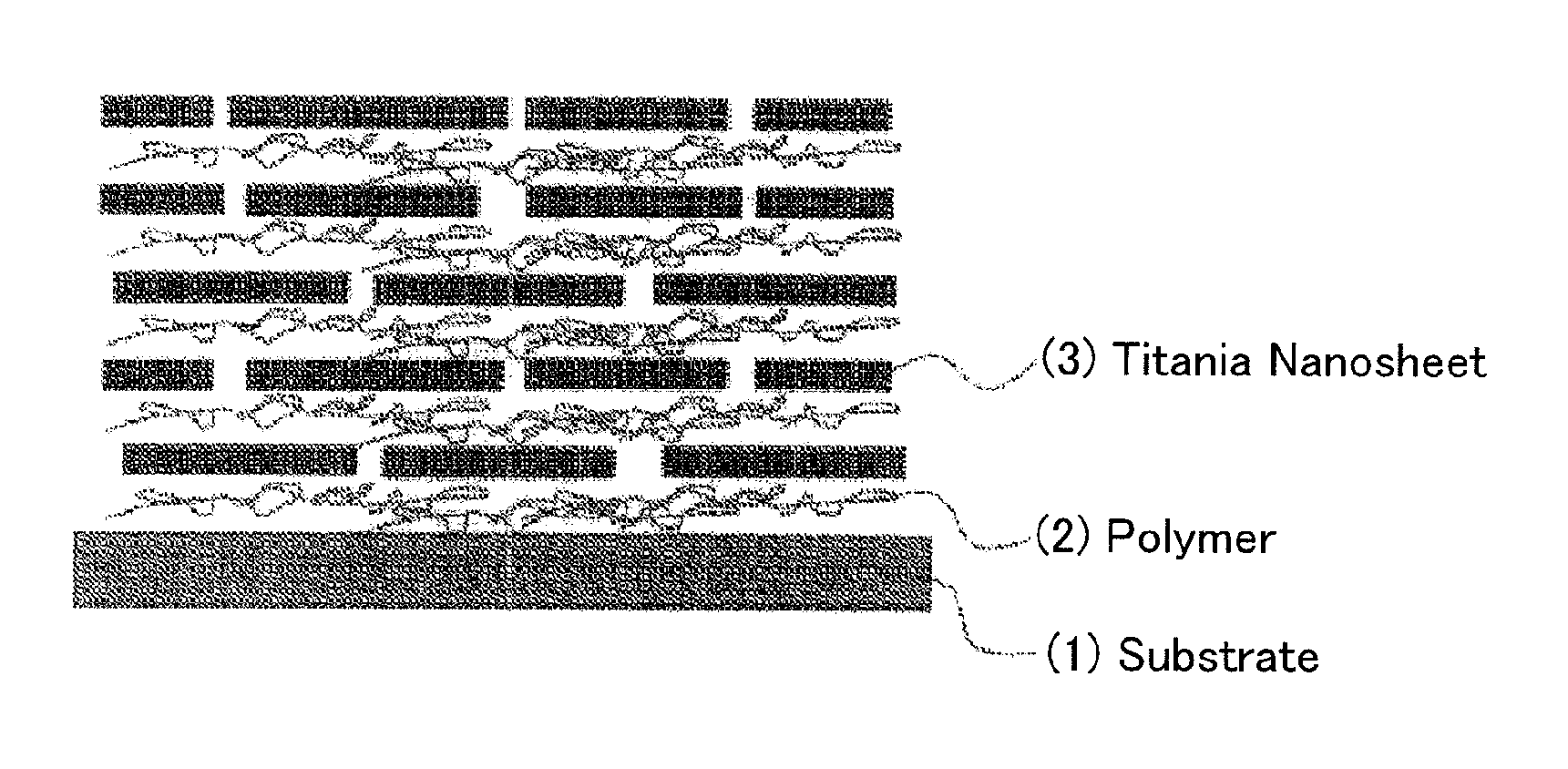Electromagnetic wave absorbent material
a technology of electromagnetic waves and absorbent materials, applied in the field of transparent electromagnetic wave absorbent materials, can solve the problems of increasing the risk of unnecessary electromagnetic wave radiation and associated interference, the inability to apply to further downsize and integration-increasing mobile instruments, and the serious problem of electromagnetic wave interference inside the instruments. it is easy to achieve the effect of high electromagnetic wave absorption effect, low cost and enabling precision control of magnetic properties
- Summary
- Abstract
- Description
- Claims
- Application Information
AI Technical Summary
Benefits of technology
Problems solved by technology
Method used
Image
Examples
example 1
[0060]In this Example, starting from a phyllo-structured titanium oxide (for example, K0.4Ti0.8Co0.2O2), a transparent magnetic substance (3) comprising titania nanosheets (Ti0.8Co0.2O2) is formed, and as shown in FIG. 1, the titania nanosheets (3) and a cationic polymer (2) polydiallyldimethylammonium chloride (PDDA) are alternately laminated on a quartz glass substrate (1) to form a magnetic film thereon in the manner mentioned below, thereby producing an electromagnetic wave absorbent film.
[0061]Phyllo-structured titanium oxide (K0.4Ti0.8Co0.2O2) was prepared by mixing potassium carbonate (K2CO3), titanium oxide (TiO2) and cobalt oxide (CoO) in a ratio K / Ti / Co of 4 / 4 / 1, and then firing it at 800° C. for 40 hours.
[0062]One g of the powder was acid-treated in 100 mL of aqueous 1 N hydrochloric acid solution at room temperature to give a hydrogen-exchanged form (H0.4Ti0.8Co0.2O2). Next, 100 mL of an aqueous solution of tetrabutylammonium hydroxide (hereinafter this is referred to as...
example 2
[0072]In this Example, starting from a phyllo-structured titanium oxide (K0.4Ti0.75Co0.15Fe0.1O2) in which Co and Fe were substituted at the titanium lattice position, a transparent magnetic film comprising titania nanosheets (Ti0.75Co0.15Fe0.1O2) was formed, thereby producing an electromagnetic wave absorbent film of the above-mentioned titania nanosheets (3) and a binder (2) PDDA alternately laminated on a quartz substrate.
[0073]Phyllo-structured titanium oxide (K0.4Ti0.75Co0.15Fe0.1O2) was prepared by mixing potassium carbonate (K2CO3), titanium oxide (TiO2), cobalt oxide (CoO) and iron oxide (Fe2O3) in a ratio K / Ti / Co / Fe of 0.8 / 0.75 / 0.15 / 0.1, and then firing it at 800° C. for 40 hours.
[0074]One g of the powder was acid-treated in 100 mL of aqueous 1 N hydrochloric acid solution at room temperature to give a hydrogen-exchanged form (H0.4Ti0.75Co0.15Fe0.1O2). Next, 100 mL of an aqueous TBAOH solution was added to 0.5 g of the hydrogen-exchanged form and reacted with stirring at ro...
example 3
[0080]In this Example, the transparent magnetic substance comprising the titania nanosheets (Ti0.75Co0.15Fe0.1O2) produced in Example 2 was used, and according to a spin coating method, an electromagnetic wave absorbent film having a thickness of a few gill was produced.
[0081]Starting from phyllo-structured titanium oxide (K0.4Ti0.75Co0.15Fe0.1O2) where Co and Fe were substituted at the titanium lattice position, and according to the same method as in Example 2, a sol solution of, as dispersed therein, rectangular nanosheets (2) represented by a compositional formula Ti0.75Co0.15Fe0.1O2 and having a thickness of about 1 nm and a lateral size of from 1 to 10 μm was produced.
[0082]Next, 20 mL of a spin-coating gelatin dispersant was added to 100 mL of the nanosheet dispersion, and stirred at room temperature to prepare a nanosheet solution.
[0083]Using the nanosheet mixture solution and repeating a series of operations mentioned below as one cycle, for a total of the necessary cycles, ...
PUM
| Property | Measurement | Unit |
|---|---|---|
| thickness | aaaaa | aaaaa |
| noise frequency | aaaaa | aaaaa |
| thickness | aaaaa | aaaaa |
Abstract
Description
Claims
Application Information
 Login to View More
Login to View More - R&D
- Intellectual Property
- Life Sciences
- Materials
- Tech Scout
- Unparalleled Data Quality
- Higher Quality Content
- 60% Fewer Hallucinations
Browse by: Latest US Patents, China's latest patents, Technical Efficacy Thesaurus, Application Domain, Technology Topic, Popular Technical Reports.
© 2025 PatSnap. All rights reserved.Legal|Privacy policy|Modern Slavery Act Transparency Statement|Sitemap|About US| Contact US: help@patsnap.com



